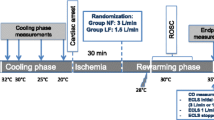Abstract
Cardiopulmonary bypass with 17 to 57 per cent dilution of hemoglobin for repair of ventricular septal defect (VSD) was applied to 26 infants weighing less than 10 kg at normal temperature. The higher flow rate was required to compensate the reduced oxygen carrying capacity and to maintain an adequate arterial pressure in proportion to a decrease of hemoglobin value. Perfusion index resulted in 3.0 to 6.5 L/m2/min in this series. When the dilution ratio of hemoglobin became more than 50 per cent and high flow rate was required, however, oxygen transfer ratio decreased remarkably on account of inadequate oxygen delivery and impaired venous return. In these cases, it was difficult to remove the diluent immediately after the operation in spite of powerful diuretic therapy. The results of the present study indicate that the safe limits of hemodilution is 50 per cent in cardiopulmonary bypass at normal temperature in infants.
Similar content being viewed by others
References
Ariyoshi, K.: A study on cardiopulmonary bypass in newborns and infants,Nihon Kyobugeka Gakukai Zasshi (J. Jap. Assoc. Thorac. Surg.) 16: 607–623, 1968 (in Japanese with English summary).
Buckley, J.M., Austen, W.G., Goldblatt, A. and Laver, M.B.: Severe hemodilution and autotransfusion for surgery of congenital heart disease.Surg. Forum. 22: 160–162, 1971.
Clark, L.C. Jr.: Optimal flow rate in perfusion, pp. 150–163, In: Extracorporeal circulation, J.G. Allen (editor), Thomas, Springfield, Ill, 1958.
Cohn, L.H., Fosberg, A.M., Anderson, W.P. and Collins, J.J. Jr.: The effects of phlebotomy, hemodilution and autologous transfusion on systemic oxygenation and whole blood utilization in open heart surgery,Chest 68: 283–287, 1975.
Dieter, R.A. Jr., Neville, W.E. and Pifarre, R.: Serum electrolyte changes after cardiopulmonary bypass with Ringer's lactate solution used for hemodilution,J. Thorac. Cardiovasc. Surg. 59: 168–177, 1970.
Gadboys, H.L., Slonim, R. and Litwak, R.S.: Homologous blood syndrome. I. Preliminary observations on its relationship to clinical cardiopulmonary bypass,Ann. Surg. 156: 793–804, 1962.
Gadboys, H.L., Jones, A.R., Slonim, R., Wisoff, B.G. and Litwak, R.S.: The homologous blood syndrome. III. Influence of plasma, buffy coat and red cells in provoking its manifestations,Am. J. Cardiol. 12: 194–202, 1963.
Gordon, R.J., Ravin, M., Daicoff, G.R. and Rawitscher, R.E.: Effects of hemodilution on hypotension during cardiopulmonary bypass,Anesth. Analg. 54: 482–488, 1975.
Grady, G.F. and Bennett, A.J.E.: National transfusion hepatitis study. Risk of posttransfusion hepatitis in the United States. A prospective cooperative study,JAMA 220: 694–701, 1972.
Harris, E.A., Seelye, E.R. and Barratt-Boyes, B.G.: On the availability of oxygen to the body during cardiopulmonary bypass in man,Br. J. Anaesth. 46: 425–431, 1974.
Harris, E.A., Seelye, E.R. and Barratt-Boyes, B.G.: Respiratory and metabolic acid-base changes during cardiopulmonary bypass in man,Br. J. Anaesth. 42: 912–921, 1970.
Kawashima, Y., Yamamoto, Z. and Manabe, H.: Safe limits of hemodilution in cardiopulmonary bypass,Surg. 76: 391–397, 1974.
Litwak, R.S., Slonim, R., Wisoff, B.G. and Gadboys, H.L.: Homologous blood syndrome during extracorporeal circulation in man. II. Phenomena of sequestration and desequestration,N. Engl. J. Med. 268: 1377–1382, 1963.
Malm, J.R. Bowman, F.O. Jr., Jasse, M.J. and Blumenthal, S.: Open heart surgery in the infant,Am. J. Surg. 119: 613–616, 1970.
Mitchell, J.H., Spronle, B.J. and Chapman, C.B.: The physiological meaning of the maximal oxygen intake test,J. Clin. Invest. 37: 538–547, 1958.
Neville, W.E., Kontaxis, A., Gavin, T. and Clowes, G.H.A.: Postperfusion pulmonary vascularities. Its relationship to blood trauma,Arch. Surg. 86: 140–151, 1963.
Osborn, J.J., Popper, R.W., Kerth, w.J. and Gerbode, F.: Respiratory insufficiency following open heart surgery,Ann. Surg. 156: 638–647, 1962.
Roche, J.K., and Stengle, J.M.: Open-heart surgery and demand for blood,JAMA 225: 1516–1521, 1973.
Roe, B.B., Hutchinson, J.C. and Swenson, E.E.: High-flow body perfusion with calculated hemodilution,Ann. Thorac. Surg. 1: 581–589, 1965.
Smith, R.M.: Biology and behavior, or factors determing of the child's response to anesthesia, pp 5–31, In: Anesthesia for infants and children, 3rd edition, R.M. Smith (editor), C.V. Mosby, Saint Louis, 1968.
Author information
Authors and Affiliations
Rights and permissions
About this article
Cite this article
Kawamura, M., Sakakibara, K., Minamikawa, O. et al. High-flow total body perfusion with severe hemodilution and normothermia in infants weighing less than 10 kg—Safe limits of hemodilution in cardiopulmonary bypass in infants. The Japanese Journal of Surgery 7, 54–64 (1977). https://doi.org/10.1007/BF02469387
Received:
Issue Date:
DOI: https://doi.org/10.1007/BF02469387




